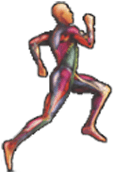 Flexibility Programs
Flexibility Programs
“Learning how to stretch correctly has been paramount for me to feel a 100% better.” Jason M
Flexibility refers to the range of motion in a muscle or a joint that can help you improve movement and athletic performance. Different types of stretching exercises produce various results in how you move and perform. Some types relax your mind and body while others prepare you for movement. The National Academy of Sports Medicine recommends that you do flexibility training before and after your workout.
Flexibility is an aspect of health that many people neglect, according to the American College of Sports Medicine. However, flexibility is important because tight muscles can create problems throughout your body. To improve your flexibility, the ACSM recommends stretching every day. You can adjust your routine to stretching at least twice a week after you have gained more flexibility. (Click here for more information of our flexibility programs)
Benefits
Less Back Pain
Tight muscles in the back and lower body can cause back pain, and improving your flexibility can help prevent and treat that pain. Yoga Journal explains that when the hamstrings are tight, they pull the pelvis down and create more pressure for the lower back. Plus, there is less stress on the spine when the hip flexors and pelvic muscles are flexible. Flexibility can also ease tension and soreness in muscles to relieve pain in the back and other areas of the body. (Click here to download our free e-book: Secrets of low back pain prevention)
Increased Range of Motion
(you are only as young as you are flexible)
If your muscles are tight, they can cause a reduced range of motion throughout your body. This can give you trouble with everyday activities such as reaching overhead to take a dish out of the cupboard. This can cause shoulder and neck problems Becoming more flexible can make these types of activities, as well as exercising, easier. It improves the range of motion throughout the body to help the body move more easily. (Click here to download our free e-book: Shoulder and neck pain guide)
Injury Prevention
You are more prone to injury of the muscles, as well as tendons and ligaments, if you are not flexible, explains Yoga Journal. The tendons around the muscles stiffen when you do not stretch and keep them flexible. If your joints are not going through their full range of motion because of tight muscles, the joints cannot attenuate forces correctly which may lead to the development of arthritis Having tight muscles gives you a reduced range of motion, which predisposes you to an injury. Likewise, if you improve your flexibility, you increase your range of motion and lower your risk of an injury to the muscles, tendons and ligaments. (Click here to download our free ebook: How to beat arthritis)
So how do we stretch?
Static Stretches
Static stretches entails holding your muscles and joints in one position for a duration of time. Such stretches are held for no more than 8 seconds during pre workout warm ups and 15 to 30 seconds for post workout cool downs. This reduces neural stimulation to the muscle which increases its length and tightness. The National Academy of Sports Medicine recommends that you do static flexibility after selfmyofascial release to further alleviate any tenderness in the muscle. For example, after rolling on your back with a foam roller, stretch your back and shoulders by placing your hands against a wall. Stand about an arm's distance away from the wall with your legs hip-width apart. Bend your torso forward at your waist and hold the stretch for five to six deep breaths. Keep your arms and legs straight to stretch your shoulders, back, buttocks and the back of your legs. (Click here for more information of our flexibility programs)
Dynamic Stretches or Ballistic Stretches
Dynamic stretches involve moving your muscles and joints together through their full range of motion quickly, one repetition after the other. This stimulates your mind and body to move before exercise and increases body temperature. The hip swing is one dynamic stretch for your hip and legs in which you swing one of your legs back and forth or side to side from a standing position. Watch a boxer enter a boxing ring. He will perform body huggers head circles these are ballistic stretches (Click here for more information of our flexibility programs)

